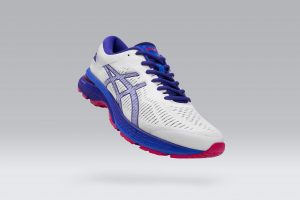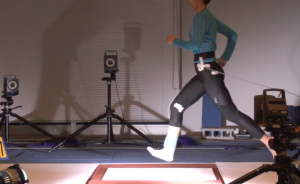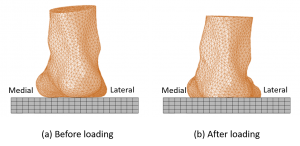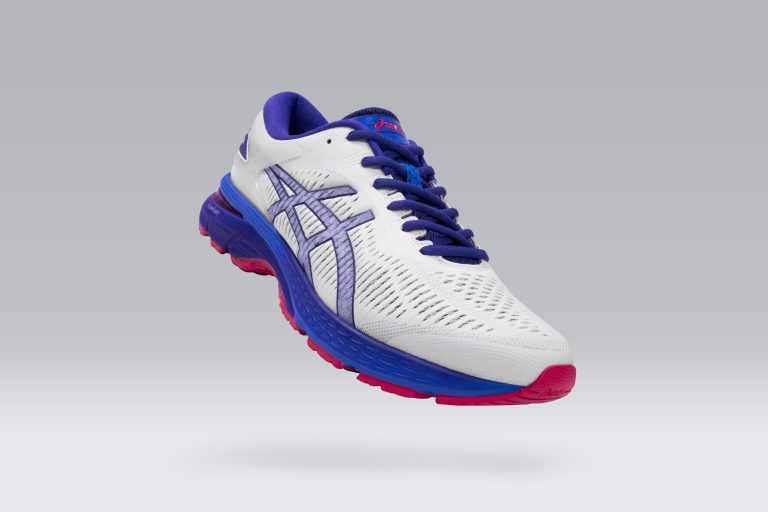In a new series, we are featuring our partners and the work they do with us in the simulation field. Our first featured partner, the Simpleware™ Product Group at Synopsys, provide software solutions for Abaqus customers. In this project, sports manufacturer ASICS used Simpleware software and Abaqus to build a high-quality model for optimizing running shoe design.
This post was written by Jessica James, Business Process Analyst at Synopsys’ Simpleware Product Group.
ASICS uses computed tomography (CT) data and Synopsys Simpleware™ software to create 3D computational models for better understanding the role of stability in running shoes. Optimizing with simulation reduces the risk of lower extremity injuries for runners, as well as enhancing performance and reducing the risk of future manufacturing errors. Sole structure and heel eversion angle are particularly important for understanding stability and the overall performance of a shoe during running.
Alongside experimental methods, models created in Simpleware software for export to SIMULIA Abaqus simulation tools help ASICS reduce prototyping time and costs, as well as manufacturing waste. The methods developed by this project demonstrate the compatibility between Simpleware software and Abaqus for image-based simulation.

Generating a Highly Accurate, Multi-Part 3D Foot Model from CT Data

A healthy female volunteers foot was scanned, using X-ray computed tomography. The image data was then imported to Simpleware ScanIP software to build a 3D model prior, to the generation of a finite element (FE) model, representing different parts of the foot (soft tissue, bones, cartilage, ligaments and plantar fascia). The detail of the model enabled ASICS to be confident in the accuracy of their anatomical simulation.

Simulating Shoe Performance

Abaqus v.6.14-2 was used with the model to calculate deformation modes on polymer foam sheets with three types of hardness. Results showed good agreement with experimental testing, validating simulation as a way of enhancing existing ASICS methods. The numerical model was confirmed to accurately predict sole stability, leading ASICS to successfully update the design of their soles to improve performance for customers.
Conclusions
ASICS have successfully created accurate, highly optimized models, tailored to specific running conditions. The model is therefore valuable for shoe stability design, reducing prototyping costs and time, and skipping practical prototyping to improve sustainability. Products have been introduced as practical designing examples, with research contributing to an improved understanding of running shoe stability and reducing excessive foot joint motion, or pronation, during the contact phase in running.
The image processing and simulation capabilities of Simpleware software and SIMULIA Abaqus made it straightforward for the researchers to build repeatable workflows for tailoring shoes to different running scenarios. The translation of this simulation into actual products demonstrate how effective the method can be for enhancing design and manufacturing processes.
How Simpleware Software Can Help
Simpleware software provides software solutions for 3D image data (MRI, CT, micro-CT…) processing for multiple industries, including the Life Sciences and Materials and Manufacturing. The software exports simulation-ready models directly to Abaqus and is widely used by customers of both software to connect 3D scanning with simulation.
You can learn more about what Simpleware software offers here: https://www.synopsys.com/simpleware.html
References: J.T. Cheung, M. Zhang, K.N An, 2004. Effects of plantar fascia stiffness on the biomechanical responses of the ankle-foot complex, Clinical Biomechanics, 19(8), 839-846; N. Nakabe, T. Nishiwaki, 2002. Development of simplified numerical foot model for sole stability design, Engineering of Sport, 4, 824-830.
Acknowledgements: Many thanks to Tsuyoshi Nishiwaki and Mai Nonogawa of ASICS Corporation, Institute of Sport Science for sharing this material presented at Science in the Age of Experience 2016.

